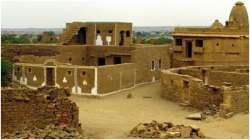The rise of Dark Tourism: Gruesome destinations in India that can give you nightmares
Just in case you were interested, we have a list of six popular dark tourism destinations in India that are waiting for you to explore their untold stories.

One of the most fast-developing forms of tourism in India, Dark Tourism, is often described as a form of travel associated with places that have experienced death, mystery, and pain. It is popular amongst people who are interested in history and want to explore the deep and dark untold stories that are buried deep in the past. It is gruesome and scary but has become popular because of its unconventional nature and experience. So, just in case you were interested, we have a list of six popular dark tourism destinations in India that are waiting for you to explore their untold stories.
Read on...
1. Jallianwala Bagh, Amritsar
On April 13, 1919, in British India, the then acting brigadier-general of the British Indian Army, General Reginald Dyer ordered the troops of his army to fire their rifles into a crowd of unarmed civilians at Jallianwala Bagh, Amritsar, without giving them any warning. The public garden, walled on all sides with only five enterances was blocked from all the sides and the troops continued to fire until all their ammunition was almost exhausted. The number of casualties estimated by the Congress was approximately 1,500 injured and 1,000 dead.
People often visit this place to see the bullets holes in the walls with some still having bullets in them.
2. Kala Pani, Andaman & Nicobar Islands
Built in 1906 by the Indian British Government to torture and isolate the Indian freedom fighters, Kalapani was often known as the prison of death. It was often said that very few who were sent there, made it back alive. The cellular jail still has all the equipment that was used to punish the prisoners. It paints a very gruesome and sad picture and visitors mostly feel acute depression after the visit.
3. Roopkund, Uttarakhand
Popularly known as the 'lake of skulls', this stunning lake is present at an altitude of around 5,000 meters above the sea level. It has a presence of almost 200 human skeletons around it. Scientists have concluded that the skeletal remains belonged to people from the ninth century who must have been hurt by something and died, probably a glacial storm. The lake remains frozen for most part of the year, but when the lake melts, remains of flesh, hair and skeletons are found here.
4. Taj Mahal, Agra
What is today known as one of the '7 wonders of the world' and is a UNESCO world heritage site, has been a source of pain to many people. There exist many stories about how Shahjahan got the thumbs of the workers chopped off after they were done with the construction of Taj Mahal. His own wife, Mumtaz Mahal sleeps in her grave just below the Taj Mahal.
5. Kuldhara Village, Rajasthan
Once a town of 83 villages in the early 19th century, Kuldhara today, is a lonely ruin. It is said that Kuldhara was abandoned by the early 13th century. It was once inhabited by Paliwal Brahmins, who fled overnight because of the dwindling water supply or because of persecution by Jaisalmer's State minister, Salim Singh. Today the Rajasthan government has developed it as a tourist attraction.
6. Union Carbide subsidiary plant, Bhopal
Often considered world's worst industrial disaster, Bhopal Gas Tragedy was a gas leak incident on the night of December 3, 1984 at the UCIL pesticide plant in Bhopal, Madhya Pradesh. Over 5 lakh people were exposed to 42 tonnes of methyl isocyanate gas, which is considered to be a highly toxic substance. People reported burning sensation in their lungs and thousands died immediately. According to the government records, the death toll went up to 3,787. Today, this site is one of the most popular dark tourism destinations in India.